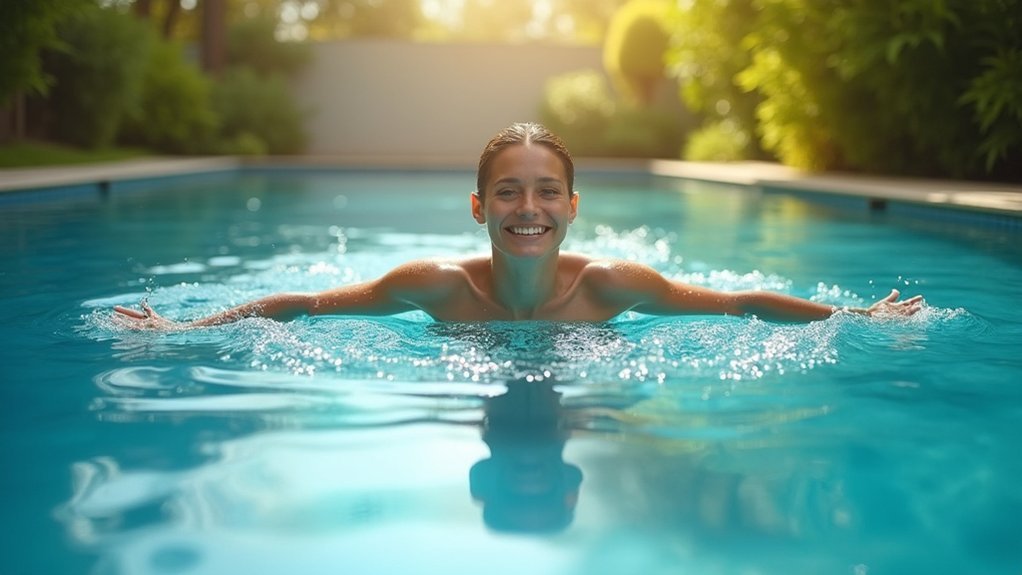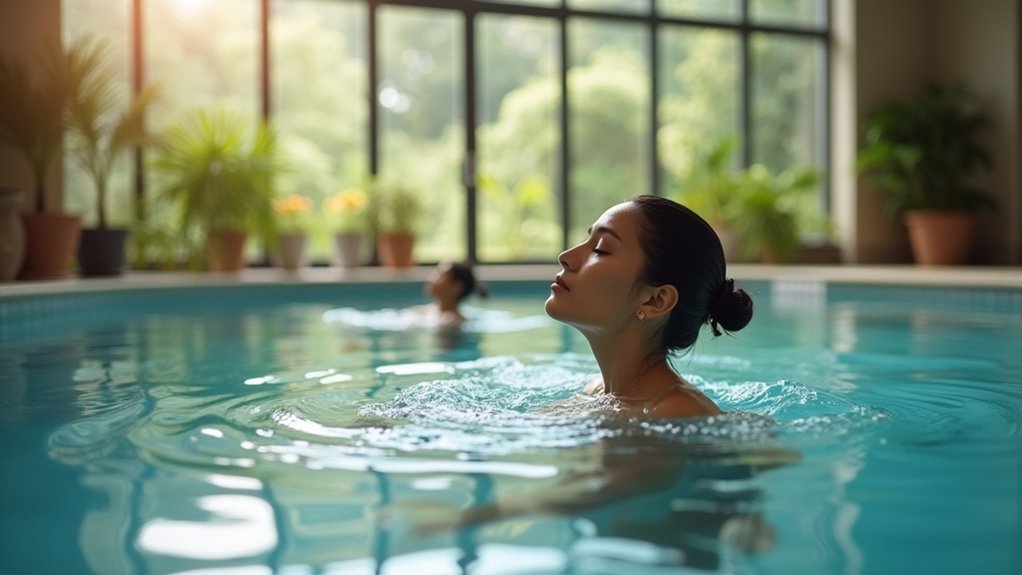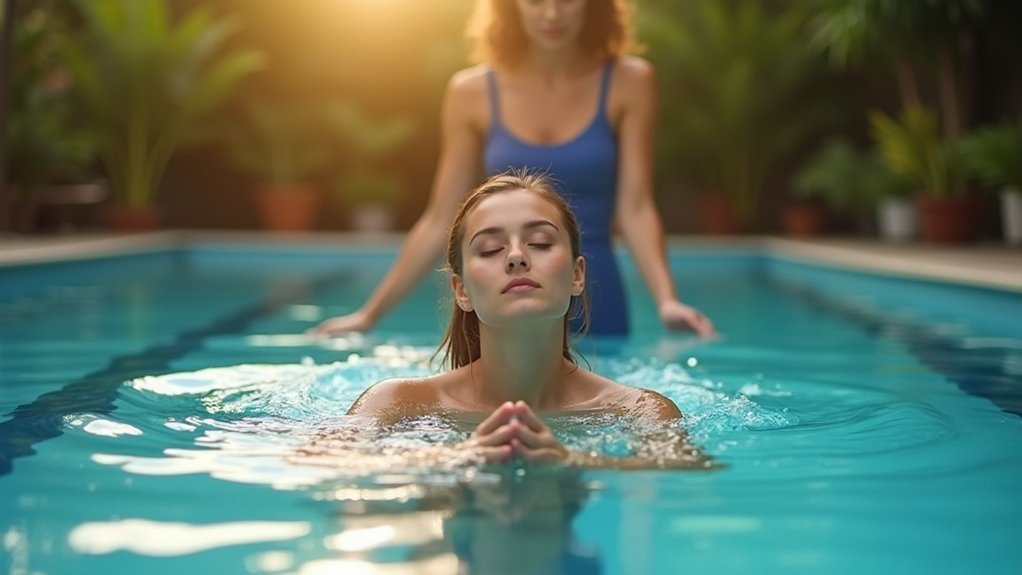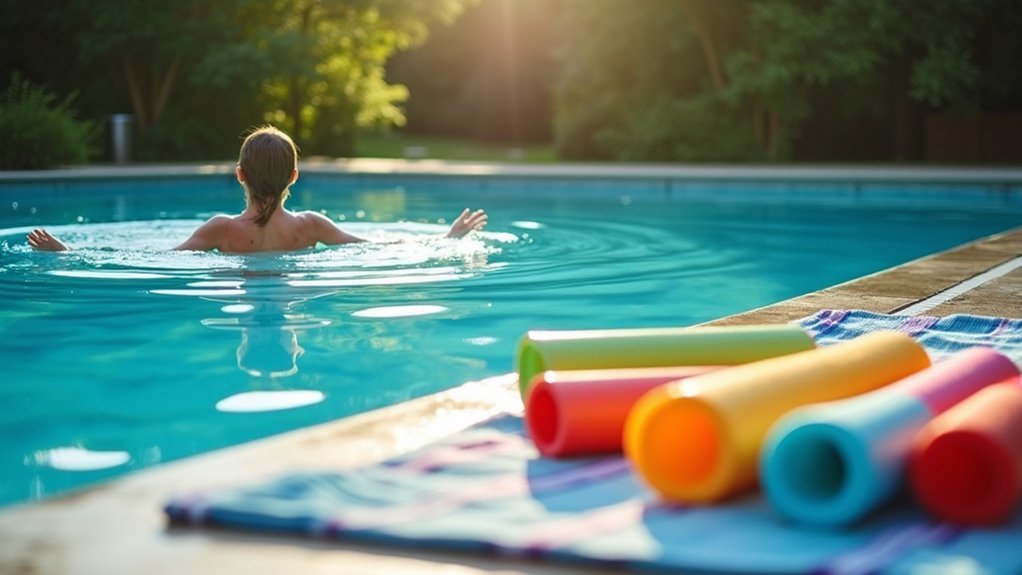Therapeutic swimming can considerably reduce anxiety through a combination of gentle exercise and water’s natural calming properties. Start by using flotation devices like noodles or belts while practicing rhythmic breathing synchronized with your movements. Gradually progress from sitting poolside to full immersion, tracking your anxiety levels before and after each session. Try floating meditation to achieve deeper relaxation and mindfulness. Regular sessions 2-3 times weekly will help establish a sustainable routine that combats anxiety on multiple levels.
Understanding the Science Behind Water’s Anxiety-Reducing Properties

While most people intuitively sense the calming effect of water, there’s compelling science behind swimming’s anxiety-reducing properties. When you swim, your brain releases endorphins and increases serotonin production, naturally lifting your mood and reducing depression symptoms.
The unique combination of water immersion and physical movement creates a powerful therapeutic effect. Water’s buoyancy reduces joint stress while providing gentle resistance that enhances the exercise benefits. Recent research from Sussex Partnership NHS and University of Portsmouth demonstrates that cold water immersion could potentially alleviate symptoms of low mood.
The rhythmic breathing patterns required during swimming help regulate your body’s stress response, inducing a meditative state similar to mindfulness practices.
Cold-water swimming triggers additional physiological responses that can specifically target anxiety and depression. Studies show swimming reduces physiological stress markers and promotes anti-inflammatory effects that combat oxidative stress—a factor implicated in anxiety disorders.
Getting Started: Essential Equipment for Therapeutic Swimming
Starting your therapeutic swimming journey requires the right equipment to maximize benefits while ensuring safety and comfort. Focus on flotation devices that support your body while reducing anxiety about being in water. For effective therapeutic sessions, having a qualified therapist present is recommended during your initial swimming attempts.
| Equipment Type | Anxiety-Reducing Benefit | Best For |
|---|---|---|
| Foam Noodles | Provides flexible support without restriction | Beginners who need subtle assistance |
| Flotation Belts | Keeps your body upright in deeper water | Water running exercises |
| Kickboards | Offers stability while focusing on breathing | Controlled movement practice |
Consider resistance equipment like aquatic paddles or gloves once you’re comfortable in water—they’ll enhance your workout while maintaining the therapeutic benefits. For those with mobility concerns, look into specialized equipment like pool lifts or integrated steps that make water entry less stressful.
Breathing Techniques and Water-Based Mindfulness Exercises

Swimming offers powerful anxiety relief through rhythmic breath control that regulates your nervous system while you’re in the water.
You’ll benefit from floating meditation techniques that use the water’s natural buoyancy to create a sense of weightlessness and freedom from physical tension.
Mindful underwater movement encourages you to focus on the present moment, connecting your breathing patterns to deliberate, gentle movements that calm your mind. These techniques are especially effective for addressing somatic symptoms like headaches and fatigue that often accompany anxiety disorders.
Rhythmic Breath Control
The power of breath control in swimming extends far beyond just staying afloat. When you synchronize your breathing with your strokes, you create a rhythm that streamlines your body position and minimizes drag, allowing you to move through water more efficiently.
This rhythmic breathing doesn’t just improve your swimming—it directly targets anxiety. As you focus on the consistent pattern of inhaling and exhaling, your mind centers on the present moment, clearing away anxious thoughts.
You’ll notice your stamina improving as you conserve energy through controlled breathing. Many swimmers find that meditation techniques can further enhance their ability to maintain calm while perfecting their breath control.
Try practicing both bilateral breathing (alternating sides) and slow underwater exhalation to enhance your technique. These patterns foster mental clarity that extends beyond the pool, developing resilience and patience you can apply to daily stressors and challenges.
Floating Meditation Techniques
Floating meditation takes rhythmic breathing to an entirely new level of mindfulness. When you’re buoyant in water, your body naturally enters a theta brain state—similar to deep meditation—enhancing creativity and mental clarity while reducing stress hormones like cortisol.
Try focusing intently on each inhale and exhale while floating. Visualize negative thoughts as smoke that dissipates with each breath out, and imagine drawing in positive energy with each breath in. This practice helps maintain focus and prevents mental wandering.
The sensory-limiting environment of water supports deeper concentration than land-based meditation. Your muscles relax in water’s buoyancy, promoting body awareness and reducing physical tension. The skin-temperature water creates an isothermal environment that eliminates distracting temperature sensations, allowing for deeper states of relaxation.
With regular practice, you’ll develop longer-lasting theta waves, improving cognitive function and establishing a profound mind-body connection that carries into daily life.
Mindful Underwater Movement
Beneath the surface, mindful underwater movement creates a unique sanctuary for anxiety relief by combining controlled breathing with deliberate body awareness.
As you glide through water, focus on each sensation—the temperature against your skin, the buoyancy supporting your body, and the rhythmic pattern of your breath.
Practice deep diaphragmatic breathing while swimming, allowing your lungs to fully expand and contract. This improves respiratory efficiency while naturally calming your nervous system.
The hydrostatic pressure of water helps release calming neurochemicals while the sensory-rich environment makes it easier to remain present. Visual imagery during swimming can significantly enhance your mindfulness practice and deepen relaxation.
Try underwater activities like deep-water bobs to release dopamine and reduce adrenaline.
The weightlessness you experience promotes muscle relaxation and enhances mind-body connection, creating sustained anxiety reduction that extends beyond your swim session.
Progressive Exposure Methods for Water-Related Anxiety

When facing water-related anxiety, gradual exposure offers one of the most effective pathways to confident swimming. You’ll progress at your own comfortable pace, starting with simply sitting poolside before moving to deeper waters as your confidence builds.
Creating a structured exposure plan helps you overcome fear systematically:
- Start small – Begin with minimal exposure like sitting at the edge with feet in the water.
- Track your progress – Record anxiety levels before and after each session to measure improvement.
- Practice breathing techniques – Use deep breathing (inhale through nose, exhale through mouth) during each step.
- Seek support – Consider working with a therapist trained in CBT or exposure therapy for personalized guidance.
Eventually, you might progress to standing in shallow water with the water level at your waist, which helps you acclimate to sensations associated with being in the water environment.
Adapting Swimming Techniques for Different Mobility Needs
Swimming offers inclusive benefits regardless of your physical mobility limitations. You can modify techniques to accommodate ankle restrictions by incorporating foam roller exercises that enhance dorsiflexion and plantarflexion, reducing strain while improving performance.
For shoulder mobility challenges, adjust your hand entry and body rotation to prevent injury while maintaining efficiency.
Hip mobility exercises like circles and flexor stretches will power your leg kicks and support smoother turns. If you experience neck tension, regular rotation exercises help achieve a streamlined position that reduces drag.
Remember that swimming requires coordinated movement across multiple joints. By strengthening smaller muscle groups around problem areas, you’ll protect ligaments from stress during high-impact movements like turns. Consistent practice of ankle distraction techniques can safely enhance your joint’s range of motion, leading to better ankle mobility over time.
Your customized approach will make swimming both therapeutic and accessible.
Creating a Personalized Aquatic Therapy Routine

Creating a personalized aquatic therapy routine begins with understanding how water’s unique properties can specifically target your anxiety symptoms.
You’ll want to customize your sessions based on your comfort level, physical abilities, and specific anxiety triggers.
When designing your routine, consider these key components:
- Frequency and duration – Start with 2-3 sessions weekly for 30 minutes, gradually increasing as your comfort grows.
- Environmental preferences – Choose quieter pool times or private sessions if social anxiety is a concern.
- Breathing integration – Incorporate specific breathing exercises that align with your swimming strokes.
- Progression planning – Begin with simple floating exercises, then advance to more complex movements as confidence builds.
The sensation of buoyancy in water creates a therapeutic oasis that naturally promotes relaxation and mental rejuvenation.
Don’t hesitate to work with a certified aquatic therapist who can help refine your routine for maximum anxiety-reducing benefits.
Measuring Progress: Tracking Mental Health Benefits of Water Therapy
You’ll need to track your progress to understand how swimming truly impacts your anxiety levels.
Consider keeping a mood journal to record your feelings before and after each aquatic session, noting any patterns in stress reduction or emotional wellbeing.
Regular self-assessments using established anxiety scales like the Spielberger State-Trait Anxiety Inventory can provide measurable evidence of your improvement over time. Taking note of changes in your sleep patterns can also indicate whether swimming is helping, as exercise typically contributes to better sleep quality which is directly linked to reduced anxiety.
Measuring Progress: Tracking Mental Health Benefits of Water Therapy
To maximize the benefits of your aquatic therapy journey, tracking your mental health improvements provides valuable insights into how swimming affects your anxiety levels. Several evidence-based methods can help you monitor your progress effectively.
- Use standardized assessments like the Beck Anxiety Inventory or Hamilton Anxiety Scale before and after your swimming program to quantify improvements objectively.
- Keep a mood journal documenting your emotional states before and after each session, capturing qualitative changes in your anxiety levels. The sensation of buoyancy in water naturally reduces physical tension, which often correlates directly with decreased anxiety scores in your tracking.
- Consider physiological tracking of stress markers like cortisol levels for scientific validation of your water therapy’s effectiveness.
- Schedule regular feedback sessions with your therapist or instructor to adjust your aquatic program based on your psychological responses to different exercises.
Consistent monitoring creates accountability and helps you identify which specific water activities deliver the greatest anxiety-reducing benefits for you.
Mood Journaling After Swimming
Mood journaling after swimming sessions provides a structured way to capture your mental and emotional shifts both immediately and over time. This practice enhances your self-awareness of swimming’s therapeutic effects, helping you recognize patterns in how water therapy influences your anxiety levels. Regular tracking can help you observe the reduced cortisol levels that typically occur after eight weeks of consistent swimming practice.
| Journal Element | Benefits |
|---|---|
| Pre-swim mood rating | Establishes baseline for comparison |
| Post-swim assessment | Tracks immediate endorphin and serotonin effects |
| Physical sensations | Links body awareness to emotional states |
| Weekly reflection | Identifies patterns and sustainable progress |
Anxiety Scale Assessments
Measuring your progress through standardized anxiety assessments provides concrete evidence of swimming’s therapeutic benefits. The State-Trait Anxiety Inventory (STAI) and Geriatric Anxiety Inventory (GAI) can objectively track your improvements as you incorporate water therapy into your routine.
- Pre-post measurements – Complete anxiety scales before starting your swimming program and at regular intervals to document changes.
- Statistical validation – Many studies show significant anxiety reductions (p<0.01) after consistent swimming interventions.
- Multiple assessment options – Choose from validated tools like STAI, HAD, or the Perceived Stress Scale based on your specific needs.
- Comprehensive tracking – Measure both immediate effects (state anxiety) and long-term changes (trait anxiety) to fully understand your progress.
Research by Graham and Robinson demonstrates that EMDR techniques can complement swimming therapy to further reduce anxiety and enhance performance in the water.
Frequently Asked Questions
Does Chlorine Exposure Affect Anxiety Levels During Therapeutic Swimming?
Chlorine exposure can impact your anxiety levels during swimming. You’ll face a trade-off – chlorine irritants might trigger respiratory stress, but swimming’s mental health benefits often outweigh these concerns when you take proper precautions.
Can Therapeutic Swimming Help With Medication-Resistant Anxiety Disorders?
Yes, you may find therapeutic swimming helpful for medication-resistant anxiety. It increases mood-regulating neurotransmitters, provides stress relief, and research suggests it can complement traditional treatments, potentially reducing your need for medication over time.
How Does Water Temperature Impact Anxiety Reduction Benefits?
Water temperature impacts your anxiety relief greatly. You’ll find warm water soothes and relaxes, while cold water stimulates endorphin release. Both reduce stress hormones, but you can choose the temperature that best suits your needs.
Are Group or Individual Aquatic Therapy Sessions More Effective?
You’ll find both approaches effective depending on your needs. Group sessions offer social support and cost benefits, while individual sessions provide personalized attention. Choose based on your comfort level and specific anxiety triggers.
How Long Do Anxiety-Reducing Effects Last After Swimming Sessions?
You’ll typically experience anxiety relief for several hours after swimming. The endorphin release can last 2-4 hours, while the mindfulness benefits might extend throughout your day, improving your sleep quality that night.
In Summary
You’ve now discovered how therapeutic swimming can transform your anxiety management toolkit. You’ll notice improvements as you consistently practice these water-based techniques. Don’t worry if progress seems slow—each session builds your confidence and calming skills. Remember to track your journey and celebrate small victories. With your personalized aquatic routine, you’re well-equipped to ride the waves of anxiety with greater ease.





Leave a Reply